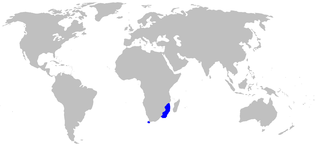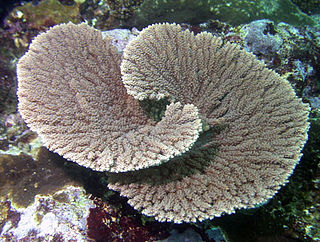
The white-spotted Izak or African spotted catshark is a species of shark belonging to the family Pentanchidae, the deepwater catsharks. It is found in the western Indian Ocean off the coasts of Natal, South Africa, southern Mozambique, Madagascar, Kenya, and Tanzania between latitudes 4° S and 37° S, at depths of between 220 and 440 m. It can grow up to 35 cm in length.

The slender catshark is a small species of catshark belonging to the family Scyliorhinidae. It is found on the upper continental slope off the coast of Suriname, French Guiana and northern Brazil, including the mouth of the Amazon River at depths between 72 and 450 metres. Its it can grow up to a length of 70 centimetres (28 in).

Quercus ilicifolia, commonly known as bear oak or scrub oak, is a small shrubby oak native to the Eastern United States and, less commonly, in southeastern Canada. Its range in the United States extends from Maine to North Carolina, with reports of a few populations north of the international frontier in Ontario. The name ilicifolia means "holly-leaved."

Acropora tenuis is a species of acroporid coral found in the Red Sea, the Gulf of Aden, the southwest, northwest and northern Indian Ocean, the Persian Gulf, the central Indo-Pacific, Australia, Southeast Asia, Japan, the East China Sea and the oceanic west and central Pacific Ocean. It occurs in tropical shallow reefs on upper slopes and in subtidal habitats, at depths of 8 to 20 metres.

Brotula barbata, commonly known as the bearded brotula, Atlantic bearded brotula, or sugarfish, is a species of cusk-eel in the genus Brotula. It lives in the Atlantic Ocean, in depths of up to 300 meters. Its coloring ranges from olive-brown to red-brown, and it grows up to be around 50 centimeters. It has a carnivorous diet, and it is oviparous.

Benthobatis moresbyi, commonly known as the dark blindray, dark blind ray, or the Indian blind numbfish, is an electric ray species in the family Narcinidae. Moresbyi was the captain of R.I.M.S. Investigator, the vessel of Indian Navy for surveying deep-water, Therefore, the species recognized with the name Benthobatis moresbyi.

Acropora clathrata, commonly known as lattice table coral is a species of stony corals belonging to the family Acroporidae. They are a zooxanthellate coral, which are generally found in fringing reefs, sheltered reefs and back reef habitats, between the depths of 5–40 m (16–131 ft). Its size varies according to the depth at which they are found, with members of the species that have larger surface areas typically found at greater depths.

Gonichthys barnesi, or Barne's lanternfish, is a species of ray-finned fish within the family Myctophidae. It is found in subtropical waters within the southern hemisphere at depths of 425 to 1000 meters during the day, and at depths of 0 to 175 meters at night. It grows to a length of 5 centimeters.
Chirodactylus jessicalenorum, the natal fingerfin, is a species of ray-finned fish within the family Cheilodactylidae. It is found in the Indian Ocean off the coast of South Africa, at depths of 3 to 20 meters below sea level.
The ornate numbfish is a species of electric ray within the family Narcinidae. It is endemic to northern Australia, inhabiting waters in the Timor and Arafura Seas near Cape Londonberry, The Kimberley, Western Australia, and the western side of Cape York. It is a benthic species, found on continental shelves at depths of 48 to 132 meters below sea level.

Selene orstedii, the Mexican moonfish, is a species of ray-finned fish within the family Carangidae. The species is found in the eastern Pacific Ocean, off the coasts of Baja California, Mexico to Ecuador. It grows to a max length of 33 centimeters, but is more commonly found at 25 centimeters in length. Adults are found in shallow coastal waters at depths up to 50 meters below sea level, usually near the seafloor. Its diet consist of squid, small crabs, small fishes and polychaetes.
Parabrotula tanseimaru is a species of ray-finned fish within the family Parabrotulidae, that is found off southern Japan in the Sagami Bay. It is a bathypelagic species, swimming at depths up to 1300 meters below sea level. It feeds on copepods and grows to around 4.9 centimeters in length, with the largest specimen being 6.2 centimeters in length. The species is only known from a single type locality collected off Sagami Bay, with 25 other specimens being caught in trawl nets up to 680 meters deep.
Trachipterus fukuzakii, the tapertail ribbonfish, is a species of ray-finned fish within the family Trachipteridae, found in the Eastern Pacific Ocean from southern California to northern Peru. It is an epilagic to mesopelagic species, being found in open oceans at depths of 500 meters. It grows at lengths of 107.1 to 143 centimeters long. It has been classified as a 'Least concern' species by the IUCN Red List, as it has a large distribution and no known major threats.
Umbrina reedi is a species of ray-finned fish within the family Sciaenidae. It is endemic to the southeastern Pacific Ocean, where it is found off the Juan Fernandez Archipelago and Isla San Felix in the Desventuradas Islands, inhabiting rocky shores at depths up to 30 meters. The maximum length of the species has been recorded at 77 centimeters.
Upeneus doriae, the gilded goatfish, is a species of ray-finned fish within the family Mullidae. The species is found distributed in the western Indian Ocean in the Persian Gulf and the Gulf of Oman. It is a demersal species, schooling over sandy substrates, reef areas, and near coastal areas at depths up to 45 meters. It grows to lengths of 20 to 30 centimeters.
Actinopyga palauensis, the Panning's blackfish, is a species of sea cucumber within the family Holothuriidae. The species distribution is in the western Pacific near areas such as Palau, the Federated States of Micronesia, Tonga, Niue, eastern Australia, and New Caledonia. It lives in reef environments at depths up to 30 meters, often being found crawling on sandy reef slopes, course sand with reef rubble, semi-sheltered bay reefs, and is occasionally found in lagoons and inshore reefs.
Saccopharynx thalassa is a species of ray-finned fish within the family Saccopharyngidae. Its known to live in the Eastern Atlantic near Madeira and the Canary Islands, and the Western Atlantic near Bermuda at depths up to 1,700 meters. It grows to a length of 107 to 110 centimeters. It has been classified as a 'Least concern' species by the IUCN Red List, as it has a wide distribution with no known major threats.

Palinurus gilchristi, the southern spiny lobster, is a species of spiny lobster within the family Palinuridae.
Gonichthys venetus is a species of ray-finned fish within the family Myctophidae. The species is found distributed in the southeastern Pacific Ocean off New Caledonia, French Polynesia to the Galápagos Islands, and central Chile. It lives at depths up to 1,310 meters, however most populations are found shallower than 1,000 meters. Adults reach up to 4 centimeters in lengths.

The spotted skiffia is a species of live bearing ray-finned fish within the family Goodeidae. Males of the species grow to a length of 5 centimeters, with a golden orange base color with varying patterns of black spots, along with a wide and long dorsal fin. Females of the species grow to a length of 6 centimeters, with silver gray coloring with black spots. This species is also kept in the aquarium hobby.












